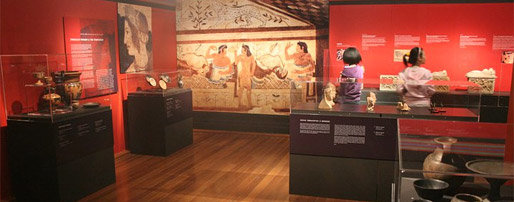The Etruscans
Jul 08

My girl and I went to the opening night of a new exhibition at the Nicholson Museum the other night: The Etruscans. The opening was very well attended—perhaps 200 or so people, nicely catered with drinks and food, and featured an informative talk on the mysterious Etruscans and their equally mysterious origins by Dr. Ted Robinson, an expert on their little-known culture.
The Nicholson Museum is a little gem in the heart of the Sydney Museum, just off the main quadrangle; like a tiny British Museum in the antipodes. Obsessive anglophiles like my girl and I can almost pretend we’re in London, or wandering through a little museum in Cambridge or Oxford. It’s not fashionable to be interested in ancient history and the age of colonial collectors, but we couldn’t care less.
Sir Charles Nicholson (1808-1903) helped establish the University of Sydney , and like so many Victorian intellectuals was an avid collector of antiquities. The standing exhibition has some beautiful pieces, including the largest collection of Egyptian antiquities in Australia, and some Egyptian mummies I remember seeing when I was very young at the old Museum of Applied Arts and Science (mentioned in a past post).
The Etruscan exhibition is small but very interesting, with a notable selection of Etruscan funerary urns, the largest of which is the equal of a similar prized piece in the British Museum. Strangely, the Etruscans liked to decorate their last resting places with violent scenes from mythology, such as the killing of Troilus by Achilles outside the gates of Troy. Surviving accounts describe them as a hedonistic, violent, pleasure-loving people, and their tombs are decorated with examples of explicit pornography and violence. And yet they also seemed to have enjoyed far greater equality of the sexes than the Greeks and Romans—men and women dined together, for example, and women kept their own names after marriage. A lot of their reputation, unfortunately, has come to us from their Romans conquerors, who were not exactly impartial when it came to recording the culture they destroyed, and saw gender equality as a sign of decadence.
It was an excellent evening, a wonderful antidote to the relentless assault of reality TV, sensationalist journalism, footy updates and lowest-common-denominator crap that gets peddled as popular culture in Sydney. In fact in an article from the 1860s when the collection was originally put on public view, a journalist accused Nicholson of being an elitist who was more concerned with collecting the relics of the dead than helping the living. Well, if a lifelong fascination with ancient history and these wonderful objects made by hands long dead is elitist, then consider me an elitist.
Incidently, I was interested to discover that noted British archaeologist Richard Miles (who wrote and presented an excellent BBC documentary called Ancient Worlds) is a Senior Lecturer at the University’s Department of Classics and Ancient History, since moving to Sydney from Cambridge. Here’s an interview with him at the Nicholson Museum.
Photo nicked from the Nicholson Museum Facebook page.

Recent Comments